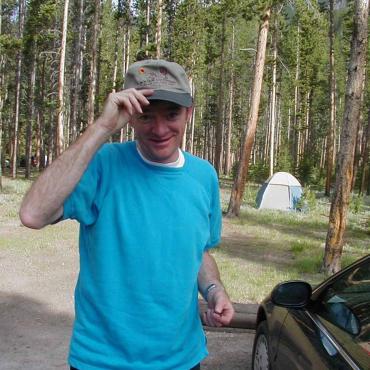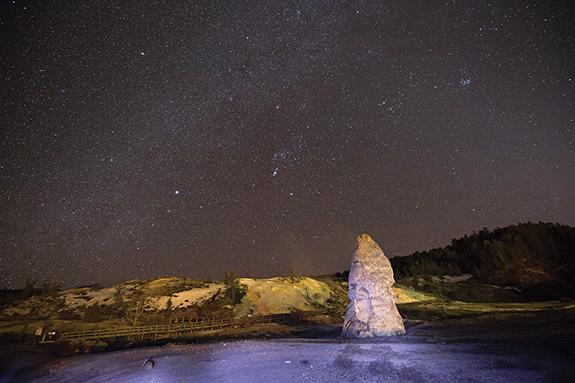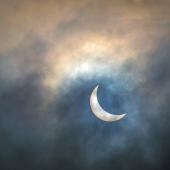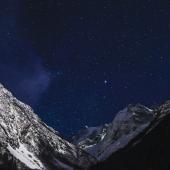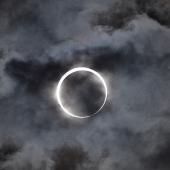Fire in the Sky
Fall's astronomical bucket-list.
Crisp autumn evenings are fine for stargazing, and for catching those must-see events that punctuate the starry hours of the day. Put them on your fall bucket-list, and consider pairing them with your favorite outdoor activity.
The Harvest Moon—traditionally the full moon closest to the autumn equinox—is an excellent reason to be out searching the skies with your main squeeze. Its fame arises from the astronomical fact that the moon, as it orbits the Earth each month, travels an apparent monthly path around the sky against the background of the stars. As the moon travels eastward on this sky-path, it rises, on average, about 50 minutes later each night.
The fall-equinox full moon, however, lies on the section of that path that makes the shallowest angle with the horizon, where the moon is not that much farther below the horizon from one night to the next. For several nights running, it rises only about 25 minutes later. The impression is that the big, bright moon rises around the same time—sunset—for several days, providing farmers in times past with light by which to extend the fall harvest after the sun went down. Hence the name.
The time of the Harvest Moon also happens to be the Chinese Mid-Autumn Festival, the 15th day of the eighth month of their lunar calendar, when the Chinese nibble moon-cakes filled with bean paste, nuts, and other delights while gazing at the moon. The Harvest Moon occurs on October 5, the Mid-Autumn Festival on October 4. Since the moon reaches full phase around midday on the fifth, either night is good.
So grab some moon-cakes (you can order some online), find a cozy ridgeline for, as the “Shine on Harvest Moon” song says, “me and my gal” or significant other, look up, and nibble away. Add a nice bottle of red to “enhance” the experience.
Planetary conjunctions provide times when the naked-eye planets, in their various orbits around the sun, appear along the same line of sight to us and thus seem very close together in the sky. There’s a good one this fall on the morning of October 5. Between 6 and 7am, before the sun comes up and as the Harvest Moon gets ready to set in the west, look in the east and just above the horizon you will see a bright Venus and a faint distant Mars in conjunction, just one-fifth of a degree apart. Unless you’re sneaking in a late-season bike ride before work, this one is a pop-out-in-your-bathrobe event, and the drink to pair it with is definitely orange juice.
The Orionid Meteor Shower flares in the sky later in the month, peaking on the night of October 20. The shower happens when Earth encounters the orbit of Halley’s Comet and bits of dust shed from the comet slam into our atmosphere and burn up in swift streaks of light. The meteors will seem to come from the constellation Orion, giving the shower its name. Under good conditions, dozens of meteors per hour may be seen in the wee hours when Orion, which rises just after midnight in the southeast, is nicely up in the sky. And since the moon is new just two days before, the sky, if clear, will be dark.
So while you’re sneaking in the last overnight of the season, try a (quiet) meteor party. Find a dark, open spot, lie down on reclining camp chairs or on blankets with your friends, aim your tootsies southeast toward Orion, and watch for bits of Halley’s Comet to streak across the sky. Coffee (with Bailey’s) is the beverage for this event.
The Zodiacal Light is a ghostly exhibition of fine dust particles in the plane of our solar system reflecting sunlight. The pre-dawn hours of September and October are a good time to see it because the ecliptic—the plane of the solar system projected against the sky—makes a steep angle with the horizon in the east before sunrise. This is another orange-juice-and-bathrobe event, but you can pick most any clear morning in September and October if you have a good view to the east.
About a half-hour before morning twilight begins (this will range from a little before 3am in early September to a little before 4:30am by late October), look east. If the sky is clear and dark, you should spy a large, fuzzy triangle of Milky Way-like radiance stretching from a wide base at the horizon up and to the right into the sky, narrowing as it goes. Think big; it will be probably be larger than you’re expecting.
Jim Manning, formerly the executive director of the Astronomical Society of the Pacific in San Francisco, lived outside Bozeman for many years and has returned to live here once again.


